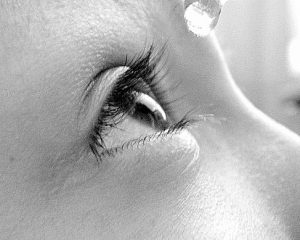Lacrimal dysfunction is a pathology that involves the entire ocular surface which includes not only the cornea, conjunctiva, eyelids and tear film, but also the lacrimal glands and Meibomian glands.
The proper functioning of each component of the ocular surface is essential for maintaining correct vision and, if this is not the case, various problems can arise, including the dry eye syndrome or Dry Eye Disease (DED).
Definition
The Tear Film & Ocular Surface Society (TFOS™), on the occasion of the Dry Eye Workshop (DEWS II) held in 2017 in Montpellier (France), updated the definition of Dry Eye Desease, first formulated in 2007 by DEWS I:
"a multifactorial pathology of the ocular surface, characterised by a loss of tear film homeostasis, and accompanied by ocular symptoms in which tear film instability and hyperosmolarity, ocular surface inflammation and damage, and neurosensory abnormalities play an aetiological role"
DED, defined in medical-scientific language "dry keratoconjunctivitis"is a complex pathology with an aetiology multifactorial.
Multiple risk factors include genetic factors, age, gender, nutrition, environmental conditions, lifestyle, work environment characteristics, immune status, hormonal status and medications that contribute to changes in the morphology and function of ocular surface components.
Epidemiology
According to the World Health Organisation (WHO), dry eye syndrome remains 'among the most ignored and underestimated disorders in modern society'despite the fact that it affects one in four of the male population over 50 and almost all menopausal women.
In fact, epidemiological data indicate that approximately 20-30% of the general population suffers after the 50 years of age, with a clear prevalence in womenespecially at the menopause.
The percentage of people affected by DED is set to grow exponentially, as prolonged and constant exposure to the digital devices increases the likelihood of the onset of this disease and favours the development of the chronic form.
Classification
Currently, two main categories of DED are identified:
-
- ADDE (Aqueous Dedicient Dry Eye), the form of DED predominantly associated with hypolacrimiaa clinical form that results from dysfunction of the lacrimal gland and is therefore defined by 'reduced tear production'.
- EDE (Evaporative Dry Eye), the form of DED predominantly associated with dyslacrimiainduced by a defect in the functioning of the Meibomian glands, the sebaceous glands present on the eyelids and responsible for producing the oily component of tears. This type is, therefore, called 'evaporation'.
Many affected patients manifest, however, a mix of both types of DED, regardless of the aetiology. Indeed, while poor quality and/or reduced flow of secretion from the Meibomian gland may cause reduced production of the lipid layer of the tear film and thus dry eye 'from evaporation', in parallel, a chronic state 'from reduced tear production'can induce an increase in the presence of pro-inflammatory cytokines and cause damage to the ductal orifices of the Meibomian glands.
 The most frequent symptoms of DED are:
The most frequent symptoms of DED are:
- Feeling of dryness in the eye
- Burning
- Photophobia (excessive sensitivity to light)
- Sensation of irritation and/or foreign body
- Difficulty opening the eyelid
- Visual impairments
All of these symptoms cause a general deterioration in the quality of vision and also have an important impact on the overall quality of life of those affected.
Causes
The causes of the onset of dry eye syndrome are numerous, as we have already mentioned, and here is an analysis of the main ones:
- Age and gender
Ageing is one of the main factors favouring the onset of DED, as it causes progressive atrophy of the lacrimal glands, which are necessary for proper lubrication of the eye. Dry eye syndrome affects the 25% of the total male populationwhereas, the majority of those affected by DED are menopausal women (the 90% is affected by DED) that have exceeded the 45-50 years of age. This high percentage is probably due to the hormonal imbalances that women experience during and after the menopause.
- Prolonged use of digital devices

The incidence of DED appears to have been influenced in recent years by prolonged, constant and increasingly early exposure to the digital deviceswhich increases the likelihood of its occurrence. The exponential increase in the use of digital devices is also associated with a reduction in the use of digital devices compared to earlier times, of physical activityespecially in open places. This reduction seems to be associated with an increased chance of the occurrence of this eye disease.
- Contact lens wear
Le contact lenses (LAC) are widely used in daily life by most people with refractive disorders. However, prolonged and often incorrect use of LACs can lead to ocular complications such as infection, inflammation or the occurrence of certain diseases, such as dry eye syndrome. The DED 'from contact lenses'is now recognised as a growing public health problem and is one of the reasons why specialist visits to ophthalmologists are increasing: data show that the frequency of occurrence of DED among LAC wearers is as high as 50%.
One factor that plays a decisive role in the occurrence of LAC DED is related to inappropriate handling and cleaning of the lenses themselves. In fact, proper cleansing of LACs using solutions suitable for removing, for example, protein and lipid deposits that naturally accumulate on the lens surface, is an essential requirement for the prevention not only of infection, but of DED itself. These solutions for cleaning the LACIn fact, they are formulated precisely for the removal of certain material deposits and at the same time have a high compatibility with the lachrymal film, the surface of the eye and all the adnexa.
- Summer period and air conditioning
During the summer period, due to the temperatures high, the natural lubrication of the eye tends to decrease due to the evaporation of the aqueous component of the tear film.
In addition, in the warmer months it is often necessary to use air conditioning to cool the environment. One of the effects of prolonged use of cold air conditioning (but also in the case of hot air conditioning) is to make rooms drier, thus causing the ocular surface not to be lubricated properly.
- Cigarette smoke, pollution and fine particles

Factors that may favour the onset of dry eye syndrome are also:
- the smoke, both active (especially in the case of smokers of more than one pack a day) and passive (also and especially in the case of children and the elderly). According to the Italian Dry Eye Centre, smokers are also two to four times more likely than non-smokers to suffer from tear film dysfunction.
- city areas particularly polluted
- the use of building materials, whose powdersin addition to damaging the respiratory system, they also cause damage to the ocular surface
- Drugs
The onset of DED can be caused by theintake of drugs such as: hormones, immunosuppressants, antihypertensives, antihistamines, diuretics, antidepressants, beta-blockers, and with regard to ophthalmic drugs, the association between DED and prolonged antiglaucomatous therapy has been demonstrated.
- Allergy
A study by a team of researchers in Miami (Florida - USA) focused on the close correlation between dry eye and ocular allergies.
The reports of 3.4 million eye examinations performed at the Veterans Affairs Eye clinic over a 5-year period (2006-2011) were analysed.
The diagnosis of dry eye occurred 606,700 times (an average of 1 in 6 patients) and the peak of cases occurred each year in April, coinciding with the peak pollen counts each spring
- Concomitance of certain diseases
Another determinant of DED is the concomitance of certain systemic diseasessuch as diabetes or thyroid-related diseases
- Sjögren's syndrome
In the western world the Sjögren's syndrome is the most common cause of hyposecretory dry eye (ADDE), as it results in an inflammatory infiltration of the lacrimal gland, typical of the most severe form of DED. This inflammation causes dysfunction and/or destruction of both acinar and ductal epithelial cells and a potentially reversible neurosecretory blockade.
Diagnosis
Dry eye syndrome is diagnosed during an eye examinationwith specific tests aimed at determining the quantity and quality of the tear film product. Commonly, the Schirmer test to measure the quantity of tears produced and the 'tear film break-up time' test to assess their quality. It is also possible to carry out a test to diagnose dry eye by measuring of tear osmolarity (which chemically is the concentration of osmoli i.e. the number of particles that contribute to the osmotic pressure of the tear film): an increase in this parameter indicates the presence of dry eye.
Treatment
The treatment of dry eye syndrome depends on both the cause and the severity of the symptoms, and the aim of treatment is always to alleviate the symptoms.
Even if, at first glance, the symptoms related to dry eye seem minor, it is absolutely not advisable to self-prescription of artificial tears, while, at the onset of the first symptoms, an examination by an ophthalmologist is recommended for a precise diagnostic framework and the prescription of the most appropriate therapy.
Symptomatic treatment usually involves the administration of eye drops or gelswhose composition is similar to tears, the so-called 'artificial tears'with lubricating and moisturising properties.
The use of artificial tears with antioxidant and re-epithelialising properties can also be considered, for which a key role is played by thehyaluronic acid:
Hyaluronic acid is a molecule that has been used for many years as an ocular lubricant due to its special characteristics. It has a structure that gives it a special ability to combine with water and excellent viscoelasticity. The property of hyaluronic acid to bind large amounts of water and that of mimicking the behaviour of mucins help to maintain the stability of the tear film and ensure optimal ocular protection and lubrication. In addition to these special properties, hyaluronic acid also plays an important biological role in corneal repair processes by promoting cell motility, adhesion and proliferation.
Artificial tears also preferably have a preservative-free formulation as the latter may aggravate the condition of the ocular surface already compromised by dryness. Preservatives are mostly used in multi-dose vials to preserve sterility, which in this case is compromised by contact between the hands and the vial. For this reason, it is advisable to use single-dose eye drops which, thanks to their special format, manage to maintain sterility without the use of preservatives potentially harmful to the eye. This preservative-free format is particularly suitable for menopausal women as well as for certain diseases (such as Sjögren's syndrome) for which the use of eye drops is necessary for a extended period.
If dry eye syndrome is associated with an infectious state or corneal complications, the ophthalmologist may prescribe the use of topical antibiotics or anti-inflammatories.
Finally, in the case of autoimmune diseases, such as Sjögren's syndrome, an overall assessment by the relevant medical team, which includes the immunologist, will be necessary.
This article can also be downloaded in pdf format. To download click here: Sheet 4 - Dry Eye
© Copyright "l'Oculista italiano" - July 2019
Dr. Carmelo Chines
Direttore responsabile
